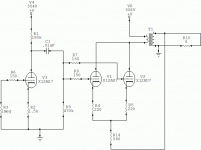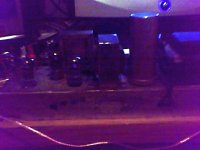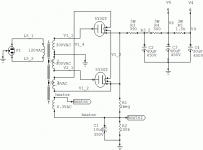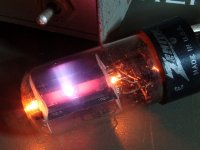12AU7 is capable of pushing 5-8 mA of current. A Broskie Aikido with 12AU7 would make a mighty nice linestage.
Hi,
Sure, f.e have a look at Tim Williams' "Hept'AU7" amp. If you want to go all 'AU7, you also can replace the driver 6SN7 with 'AU7 with little modification, if any.
http://webpages.charter.net/dawill/tmoranwms/Circuits/Hept%27AU7.gif
Regards,
Tom Schlangen
I apologize if this has been covered before (I did try to search for a thread!) but could one make an amp using only 12AU7 tubes in class A or AB?
Sure, f.e have a look at Tim Williams' "Hept'AU7" amp. If you want to go all 'AU7, you also can replace the driver 6SN7 with 'AU7 with little modification, if any.
http://webpages.charter.net/dawill/tmoranwms/Circuits/Hept%27AU7.gif
Regards,
Tom Schlangen
I've been wanting to mess with the JJ ECC99 for years, but haven't found a good reason to try them. In the back of my mind, I've been picturing a headphone amplifier.
So instead of a zillion 12AU7 valves in parallel, how about some 6CG7? Take another step up (in size and power) and use a bunch of ECC99? Filament current would probably be an issue!
The 6CG7 is one of my all-time top favorite valves.
Either way, a bunch of small triodes in parallel with an EL84-style transformer will work. Edcor (and several other companies) make a 7.6k : 6 output transformer that would be great with a handful of ECC99.
So instead of a zillion 12AU7 valves in parallel, how about some 6CG7? Take another step up (in size and power) and use a bunch of ECC99? Filament current would probably be an issue!
The 6CG7 is one of my all-time top favorite valves.
Either way, a bunch of small triodes in parallel with an EL84-style transformer will work. Edcor (and several other companies) make a 7.6k : 6 output transformer that would be great with a handful of ECC99.
Tim De Paravicini got 20 watts per channel using only 12AX7s (10 per channel) in his V20 intregrated amp.
Stereophile: EAR V20 integrated amplifier
http://www.blackdahlia.com/tipindex/Tip__13/tip__13.html
Stereophile: EAR V20 integrated amplifier
http://www.blackdahlia.com/tipindex/Tip__13/tip__13.html
Last edited:
Digging up this thread since it made me curious if a decent little amp could be made with au7's, and it doesn't seem as if the op got a decent answer. I used a maggie console amp 197-10 as the platform, originally a stereo EL84 amp. It has a 300 0 300 transformer with 5v and 6.3v taps, using the original 5y3gt rectifier and the small current draw of the amp netted a B+ of 320v before the rc filters. The OT's are 5.2k/3.2 ohm units, and I use a pair of pioneer cs-g203 speakers with a 6ohm nominal impedance,although strangely all the speakers in it are stamped 8ohm. I get about 1 watt out using both sections of the au7's in parallel in single ended fashion with about 295v across them and about 8ma current per section. It sounds quite good although a little lacking in the low end bass.
Attachments
jj ECC99 or 6H30 are more suitable
Hagerman Technology LLC: Cymbal Vacuum Tube Push/Pull Power Amplifier 6H30 6W DIY Kit
Hagerman Technology LLC: Cymbal Vacuum Tube Push/Pull Power Amplifier 6H30 6W DIY Kit
It would be great to be nearby when the US military scraps those old triode based supercomputers.
Most of that stuff was scrapped years ago. Apparantly there was an eccentric collector in central Florida who bought several tons of this stuff in the 1970's. It was all stored in warehouses and shipping containers until he passed away around 2000. After a few attempts to sell off the useable material, a moving crew was called to take it all to a scrap dealer. About 200,000 tubes were just dumped into boxes, breaking about half of them.
My friend (a surplus dealer) purchased the entire lot for about $1000. He told me I could have all of the tubes if I would help him sort and move the lot. He got his money back just in the scrap value of all the metal. After tossing the obviously damaged tubes into the scrap heap, I wound up with about 100,000 tubes.
It took me about 5 years to go through every box and dispose of all of the broken tubes and tubes with obvious physical damage (mostly severely corroded pins). That left me with about 50,000 tubes. I have roughly sorted many of them. I have since sold off all of the tubes that were not suitable for audio (HV rectifiers, big thyratrons, etc.). I have also sold the tubes that could be used in audio, but that I would never get to in my lifietime. (several hundred NIB 1625's, odd voltage TV tubes, and thousands of 6AK5's).
As the warehouse keeps raising the rent, I keep downsizing my collection. I still have (and plan to keep) about 500+ 12AU7 variants. Yes sooner or later I will be finding the melting point of some less than stellar quality 12AU7's.
Back to the original thought. Would I accept another offer of free military surplus tubes again? NO. I now realize that I have spent far more time and money with this collection that it would have cost to buy every tube that I have ever used brand new.
@jerluwoo; Excellent little amp! I doubt I'll need anything more than one or two watts, and this is a simple enough design that I could whip it up in an afternoon! I'll have to inventory my iron, but it's definitely something that I could build! Thanks very much for chiming in!!
@tubelab.com; MY goodness-- I've read many (many many many) of your articles and I'm more than honoured to have you chime in on my thread-- that's QUITE the story. I wouldn't mind taking some of those tubes off your hands
@tubelab.com; MY goodness-- I've read many (many many many) of your articles and I'm more than honoured to have you chime in on my thread-- that's QUITE the story. I wouldn't mind taking some of those tubes off your hands
Yes sooner or later I will be finding the melting point of some less than stellar quality 12AU7's.
I've easily put 20W into a pair of plates, using my induction heater externally. They glowed red. Give those little bastards hell.
Tim
I've easily put 20W into a pair of plates, using my induction heater externally. They glowed red.
Well, yeah.... 20 watts into a 12AU7, I would expect white hot. I doubt that you could do this under normal (well abnormal) conditions. I don't think that the cathode of a 12AU7 could emit 20 watts worth of electrons. If it could the little strap that connects the cathode to the pin would blow like a 100 mA fuse at the first arc. Since I don't have access to an induction heater, I found a more "normal" method of generating some plasma that doesn't involve a microwave oven.
You need a dual section tube (like the 12AU7) and 4 power supplies, one for the heater, another to apply a positive voltage to the grid, a third to apply a positive voltage to the plate, adjustable current limiting is a plus, a fourth power supply is used to strike and support a plasma between the two plates. Adjustable current limiting is required.
Set the first 3 power supplies up as described to one section of the tube, and adjust the supplies to get the plate of that section glowing red. Red enough to emit electrons. Allow it to glow for a while to release some "gas" into the vacuum. The 4th power supply is connected between the two plates negative to the glowing plate. Set the voltage to a few hundred volts, and slowly advance the current. The second plate will start to glow, and eventually a plasma will form between them.
It took several tries to get one going and control it for long enough to soften the glass. Once this happened the glass bulged outward indicating that the vacuum had all been used up and a positive pressure developed inside the tube.
I made a bulging 6AS7 about 15 years ago, but I don't know where it is now. I have a few hundred really ugly 6AS7's to play with plus a big box full of 12AU7's.
Well, yeah.... 20 watts into a 12AU7, I would expect white hot. I doubt that you could do this under normal (well abnormal) conditions. I don't think that the cathode of a 12AU7 could emit 20 watts worth of electrons. If it could the little strap that connects the cathode to the pin would blow like a 100 mA fuse at the first arc. Since I don't have access to an induction heater, I found a more "normal" method of generating some plasma that doesn't involve a microwave oven.
You need a dual section tube (like the 12AU7) and 4 power supplies, one for the heater, another to apply a positive voltage to the grid, a third to apply a positive voltage to the plate, adjustable current limiting is a plus, a fourth power supply is used to strike and support a plasma between the two plates. Adjustable current limiting is required.
Set the first 3 power supplies up as described to one section of the tube, and adjust the supplies to get the plate of that section glowing red. Red enough to emit electrons. Allow it to glow for a while to release some "gas" into the vacuum. The 4th power supply is connected between the two plates negative to the glowing plate. Set the voltage to a few hundred volts, and slowly advance the current. The second plate will start to glow, and eventually a plasma will form between them.
It took several tries to get one going and control it for long enough to soften the glass. Once this happened the glass bulged outward indicating that the vacuum had all been used up and a positive pressure developed inside the tube.
I made a bulging 6AS7 about 15 years ago, but I don't know where it is now. I have a few hundred really ugly 6AS7's to play with plus a big box full of 12AU7's.
When I first read this, I thought "Why".
Then it hit me .... Because you can !
Andy
.
When I first read this, I thought "Why". Then it hit me .... Because you can !
When you have thousands (an understatement) of unusable (in a real application) tubes and you have a problem throwing anything away until all usefulness has been exhausted, you get creative (or maybe uncreative).
There were thousands of broken tubes. Exploring their inner construction is an educational experience. It seems that there were a disproportionate number of broken 807's and 1625's. Before tossing them, I took one or two apart from every different manufacturer. This is why I can state that an (original) 807 IS a 6L6GA in a different bottle (an often disputed fact). Later vintage 807's may contain 6L6GB or even 6L6GC guts (I found 1), but don't count on it.
There were thousands of tubes with severely bent, broken, or corroded pins. After straightening and cleaning some of them only to find that the pins break off in the socket after a few thermal cycles, I faced the inevitable. They must go, but not without some "testing".
Then there were tubes that had already been abused. I found a 6AX4 that had a hole burned right through the plate. To my amazement the tube still worked and had a voltage drop that was still in spec. Would you trust your expensive components to a tube with a see through plate? I won't, so it got "tested". Note the "death ray" coming from the hole.
Attachments
Reviving an old thread - I'm about to try your schematic. I'm just a bit confused that the 12AU7 cathodes have no connection to ground other than via OPT secondary. Is this indeed how you have it running or is there something missing on the drawing?Digging up this thread since it made me curious if a decent little amp could be made with au7's, and it doesn't seem as if the op got a decent answer. I used a maggie console amp 197-10 as the platform, originally a stereo EL84 amp. It has a 300 0 300 transformer with 5v and 6.3v taps, using the original 5y3gt rectifier and the small current draw of the amp netted a B+ of 320v before the rc filters. The OT's are 5.2k/3.2 ohm units, and I use a pair of pioneer cs-g203 speakers with a 6ohm nominal impedance,although strangely all the speakers in it are stamped 8ohm. I get about 1 watt out using both sections of the au7's in parallel in single ended fashion with about 295v across them and about 8ma current per section. It sounds quite good although a little lacking in the low end bass.
Reviving an old thread - I'm about to try your schematic. I'm just a bit confused that the 12AU7 cathodes have no connection to ground other than via OPT secondary. Is this indeed how you have it running or is there something missing on the drawing?
It's how he is applying some cathode feedback, correct as shown. Make sure you phase the secondary winding correctly - gain should decrease when connected as shown.
It's how he is applying some cathode feedback, correct as shown. Make sure you phase the secondary winding correctly - gain should decrease when connected as shown.
kevinkr has it right. Didnt want to use GNF since it kinda killed the open soundstage in the mid and treble, but, it needed a little help in the bass end. Takes an output with really high primary inductance to get good bass. I was simply using the old magnavox OP's that are a little small.
- Status
- This old topic is closed. If you want to reopen this topic, contact a moderator using the "Report Post" button.
- Home
- Amplifiers
- Tubes / Valves
- 12AU7 Amp?



